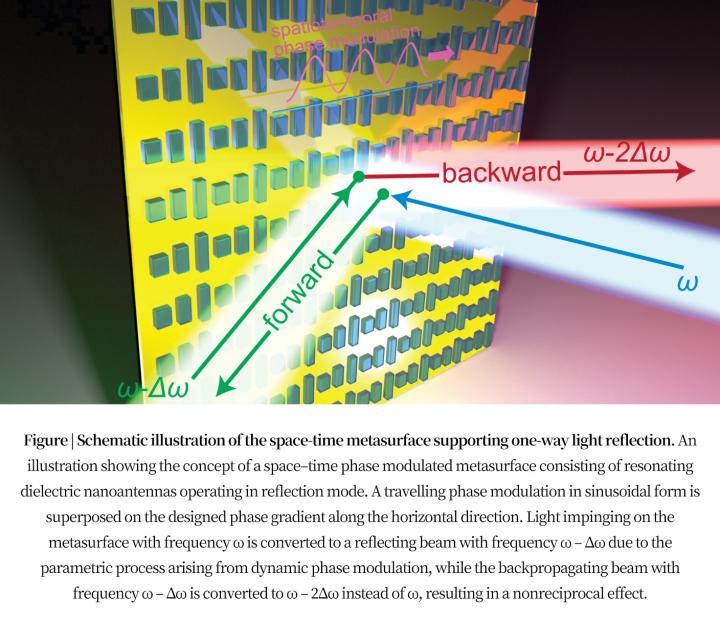
Credit: by Xuexue Guo, Yimin Ding, Yao Duan, and Xingjie Ni
Light propagation is usually reciprocal meaning that the trajectory of light travelling in one direction is identical from that in the opposite direction. Breaking reciprocity can make light propagate only in one direction. Optical components that support such unidirectional flow of light, for example isolators and circulators, are indispensable building blocks in many modern laser and communication systems. They are currently almost exclusively based on the magneto-optic effect, making the devices bulky and difficult for integration. It is in great demand to have a magnetic-free route to achieve nonreciprocal light propagation in many optical applications.
Recently, scientists developed a new type of optical metasurface with which phase modulation in both space and time is imposed on the reflected light, leading to different paths for the forward and backward light propagation. For the first time, nonreciprocal light propagation in free space was realized experimentally at optical frequencies with such an ultrathin component.
“This is the first optical metasurface with controllable ultrafast time-varying properties that is capable of breaking optical reciprocity without a bulky magnet,” said Xingjie Ni, the Charles H. Fetter Assistant Professor in Department of Electrical Engineering at the Pennsylvania State University. The results were published this week in Light: Science and Applications.
The ultrathin metasurface consists of a silver back-reflector plate supporting block-shaped, silicon nanoantennas with large nonlinear Kerr index at near-infrared wavelengths around 860?nm. Heterodyne interference between two laser lines that are closely spaced in frequency was used to create efficient travelling-wave refractive index modulation upon the nanoantennas, which leads to ultrafast space-time phase modulation with unprecedentedly large temporal modulation frequency of about 2.8 THz. This dynamic modulation technique exhibits great flexibility in tuning both spatial and temporal modulation frequencies. Completely asymmetric reflections in forward and backward light propagations were achieved experimentally with a wide bandwidth around 5.77 THz within a sub-wavelength interaction length of 150 nm.
Light reflected by the space-time metasurface acquires a momentum shift induced by the spatial phase gradient as well as a frequency shift arisen from the temporal modulation. It exhibits asymmetric photonic conversions between forward and backward reflections. In addition, by exploiting unidirectional momentum transfer provided by the metasurface geometry, selective photonic conversions can be freely controlled by designing an undesired output state to lie in the forbidden, i.e. non-propagative, region.
This approach exhibits excellent flexibility in controlling light both in momentum and energy space. It will provide a new platform for exploring interesting physics arisen from time-dependent material properties and will open a new paradigm in the development of scalable, integratable, magnet-free nonreciprocal devices.
###
Media Contact
Xingjie Ni
[email protected]
Related Journal Article
http://dx.




